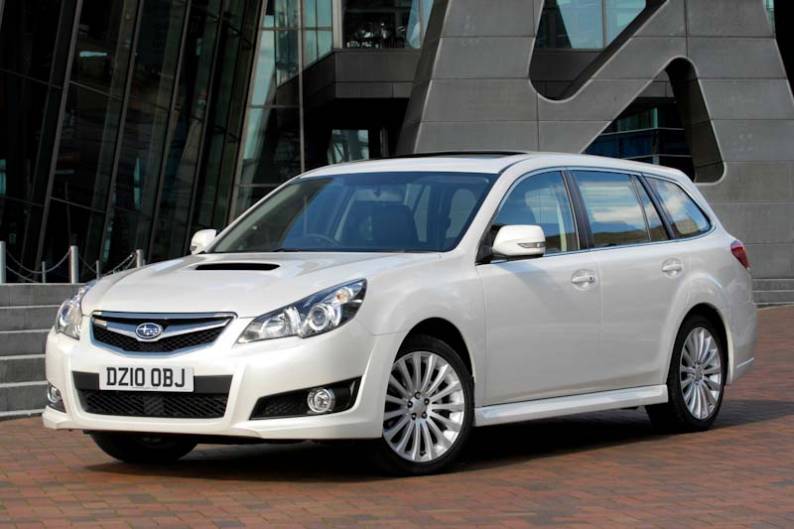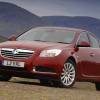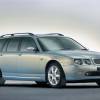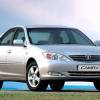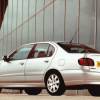
RAC sale – up to 33% off*
• Roadside cover from £5.29 a month†
• We get to most breakdowns in 60 mins or less
• Our patrols fix 4/5 breakdowns on the spot

By Jonathan Crouch
Introduction
Subaru decided to only offer its fifth generation Legacy medium range model in this country in its estate 'Tourer' bodystyle. This design was larger than its predecessor to try and elevate itself into content with executive class estates as well as Mondeo-sized models. Plus it offered the usual Subaru virtues - distinctive Boxer engines, all-wheel-drive and metronomic reliability. Does all that add up to a strong used car buy? Let's find out.
Models
5dr estate (2.5 petrol / 2.0 Diesel)
History
Throughout its production life between 1989 and 2014, Subaru's Legacy tried to offer family estate car buyers a different approach. Four-wheel drive security for the price of 2WD mediocrity. Flat four engines unique enough for you to miss their distinctive thrum once you'd moved to something more mundane. And a refreshing approach to design that set this design apart in a sea of ordinary alternatives. All that worked for this car in the Nineties and Noughties but by the time the fifth generation was launched in 2010, it was clear that a little more might be needed to sustain sales. Being different might no longer be quite enough.
In this guise, the UK importers decided to limit themselves to the Tourer estate bodystyle and in this form, the MK5 Legacy was usefully bigger than before, making it a more realistic alternative to Executive-class 4x4 estate cars like Audi's A6 Avant quattro and Volvo's XC70 as well as a Mondeo-sized models like the Skoda Octavia Scout. This increase in size also enabled this legacy to to distance itself from Subaru's more affordable Forester 4x4 estate. So we've this longer, wider, taller and in every way bigger Legacy. Will it be a bigger draw? Let's find out.
What You Get
With its added bulk, this fifth generation model became a more imposing sight on the road. You couldn't call it pretty but it does look lower and wider than the previous MK4 model, with muscular curves around the front end. There are the usual SUV-like prominent wheel-arches, while the strong belt line and a chrome-rimmed glass-house are intended to give a premium feel. Whether you agree with that or not, what's not in doubt is that this fifth generation Legacy was usefully bigger than its predecessor against virtually every criteria you could care to name and that shows up where it's most important - inside.
Owners of older Legacys might miss the frameless doors that were a feature of previous models but once seated, they'll certainly notice the much bigger cabin, its size hardly surprising given that most of the external dimensions are up by around 50mm over the MK4 model, along with an 81mm wheelbase increase. That equates, amongst other things, to 21mm more front seat headroom than the fourth generation Legacy could provide. At the wheel, though there's nothing really to catch the eye, the dash design offered a step forward in quality from anything Subaru had offered us prior to the launch of this car in 2009. There's an electrically operated seat to help you find the ideal driving position and all the major controls fall easily to hand, though the electronic parking brake can be a little awkward to find. Rear seat passengers, like those at the front, also benefit from the extra space on offer, enjoying 99mm more rear seat legroom and the ability to recline their seats to better while away longer journeys.
We've already talked about the way this car is quite the match of rivals like Skoda's Superb Estate 4x4 and Volvo's V70 AWD for interior space. We'd also add that the fifth generation version of this car is a realistic alternative to even pricier stuff like BMW's 5 Series Touring or Audi's A6 Avant. This is perhaps most obvious when it comes to bootspace: paying lots more cash for, say a BMW 5 Series Touring or an Audi A6 Avant certainly doesn't buy you any more and though this Subaru can't quite match Skoda's Superb Estate, it can in this MK5 guise equal or better the class favourite, Volvo's V70, in just about every dimension. The Legacy's space is easy to access too, thanks to the ease of seat-folding courtesy of well placed levers, located just inside the tailgate. Using these increases luggage capacity from 526 to 1677-litres.
What You Pay
Please fill in the form here for an exact up-to-date information.
What to Look For
Japanese reliability is second to none and the Legacy is typical. However, there have been reports of headlamps burning out, issues that typically cost around £130 in parts costs to fix. A few cars have exhibited excessive wind noise at speed too, an issue that can be corrected by replacing the window seals. Corrosion is notable by its absence, as are electronic gremlins.
The flat-four engines have existed in one form or another for many years now and that's good news, as the technology's well proven and has been regularly updated. Don't be put off a Legacy just because it's a bit different under the bonnet. Gearboxes are equally well-proven, though on the Lineartronic auto, there have been reports of an awkward shift mechanism between 'Park' and 'Drive' - and visa versa.
Replacement Parts
(Based on a 2012 Legacy Tourer 2.0D ex VAT - prices quoted for guidance purposes only) A brake pad set assembly will set you back around £8 and a brake disc about £29. Expect to pay around £36 for a cylinder head gasket, around £50 for a shock absorber and £68 for a clutch disc. For a radiator fan, you're looking at around £160.
On the Road
The biggest boost Subaru could have given to Legacy sales was introduced before this MK5 version even saw the light of day. It seems inconceivable now to think that for nearly two decades, this car was sold without diesel power but such is the case, the unique 2.0-litre boxer engine only arriving under the Legacy's bonnet towards the end of the MK4 model's production run in 2008. Within a few years, almost all Legacy customers were choosing this 150bhp unit, though a 167bhp 2.5-litre petrol model with clever Lineartronic CVT automatic transmission was available in the MK5 model range for those who really couldn't abide the black pump.
To understand the diesel's popularity, you don't have to drive one very far, it's 350Nm of torque offering pulling power that dwarfs the petrol version's breathless 229Nm figure and takes the Legacy 2.0D from rest to sixty in 9.2s if you're quick with the 6-speed manual gearbox. And of course, this wouldn't be a proper Subaru without permanent 4WD, in this case a Symmetrical set-up adapted according to the engine and gearbox options you've chosen. The system distributes power in a 50:50 split between the front and rear wheels via a viscous coupling centre differential and the functioning's pretty simple. If grip is in short supply at one axle, more power is diverted to the opposite one.
As for handling, Subaru's engineers went here for a more comfort-orientated approach: in other words, they benchmarked a Volvo V70's solid but unexciting responses rather than a BMW 3 Series Touring's more dynamic ones. The result is a less entertaining Legacy than its MK4 predecessor but also one that rolls less, rides better and will be preferable on longer journeys.
Overall
By going large, this fifth generation Legacy Tourer was looking to distance itself a little from the badge-conscious compact executive estates that had always overshadowed it in the past. It certainly seems a more realistic proposition targeted at Volvo and Skoda than it did when pitched towards smaller BMW and Audi estates. And you get all the usual Subaru virtues in terms of reliability and build quality. The result, we think, is a strong used car buy if you're in the market for a family-sized estate with a little extra winter weather or towing capability.
It'll help too, that some of Subaru's trademark individuality remains here. The characterful engines. The permanent four-wheel drive. And of course, the strong value proposition. Some things never change.

